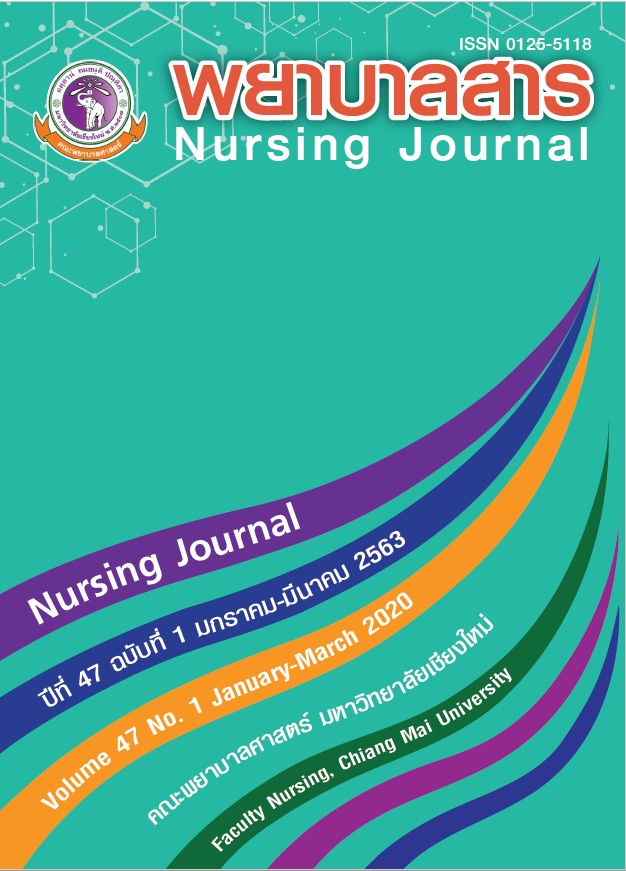Head Nurses’ Transformational Leadership and Registered Nurses’ Voice Behaviors, University Hospitals, Northern Region
Keywords:
Transformational Leadership, Voice Behaviors, Registered Nurses, University Hospitals, Head NursesAbstract
Voice behavior of employees is a vital factor to facilitate changes and to create innovation in an organization. Therefore, head nurses should motivate Registered Nurses to have voice behavior. The purposes of this descriptive correlational study were to explore the perceived transformational leadership of head nurses, the level of voice behavior among nurses and the relationship between perceived transformational leadership and voice behavior among nurses in University Hospitals Northern Region. The sample consisted of 352 Registered Nurses who have at least one year of experience were chosen by stratified random sampling. The study instrument used was a questionnaire that included three parts: 1) demographic data questionnaire, 2) voice behaviors questionnaire, and 3) Leadership Practices Inventory. The Cronbach’ alpha coefficients of the voice behaviors questionnaire and the Leadership Practices Inventory were .89 and .88, respectively. Data were analyzed using descriptive statistics and Spearman’s rank-order correlation.
The study results were as follows
- Registered Nurses perceived the transformational leadership of head nurses at a high level ( = 3.63, SD = .77). About 88 % of registered nurses had a high level of voice behavior, whereas approximately 12% of the nurses had to improve their voice behavior.
- Perceived head nurses’ transformational leadership had a positive correlation with voice behaviors (rs = .239, p < .01)
The results of this study could help nurse managers to understand the association between perceived head nurses’ transformational leadership and voice behavior among registered nurses. It is recommended that transformational leadership should be a requirement of head nurses to practice in order to motivate followers to voice their suggestions for changes.
References
Aranzamendez, G. (2014). Relationship of perceived direct supervisor affiliation, direct supervisor leadership style, and nurses’ voice behavior (Doctoral dissertation, Texas Woman’s Univer -sity, United States).
Benner, P. (1984). From novice to expert. Menlo Park, CA: Addison-Wesley.
Bowles, A., & Bowles, N. B. (2000). A comparative study of transformational leadership in nursing Development unit and conventional clinical setting. Journal of Nursing Management, 8 (2), 69-76.
Boychuk, E. J., & Cowin, L. (2004). Multigenerational nurses in the workplace. Journal of Nursing Administration. 34 (11), 439-501.
Chitonnom, M. (1999). Leadership of Head Nurses and Organizational Commitment of Staff
Nurses in Maharaj Nakorn Chiang Mai Hospital (Master’s thesis, Chiangmai University). (In Thai)
Danket, J. (2000). Leadership Behaviors of Head Nurses and Productivity of Staff Nurses in
Community Hospitals Region 10 (Master’s thesis, Chiangmai University, Chiang Mai).(In Thai)
Detert, J. R., & Burris, E. R. (2007). Leadership behavior and employee voice: Is the door really open?. Academy of Management Journal, 50 (4), 869–884.
Herzberg, F., Mausner, B., & Snyderman. B. B. (1959). The Motivation to Work. New York: John Wiley and Sons, lnc.
Kouzes, J. M., & Posner, B. Z. (1995). The leadership challenge (2 nd ed.). San Francisco, CA: Jossey-Bass.
Kraisree, N. (2013). Transformational leadership, organizational culture and organizational effectiveness as perceived by professional nurses in community hospitals, Northern region (Master’s thesis, Chiangmai University). (In Thai)
Liu, W., Zhu, R., & Yang, Y. (2010). I warn you because I like you: Voice behavior, employee identifications, and transformational leadership. The Leadership Quarterly. 21 (1), 189–202.
Morrison, E. W., & Milliken, F. J. (2000). Organizational silence: A barrier to change and development in a pluralistic world. Academy of Management Review, 25(4), 706–725.
Morrison, E. W., Wheeler-Smith, S. L., & Kamdar, D. (2011). Speaking up in group: A cross-level study of group voice climate and voice. Journal of Applied Psychology, 96 (1), 183-191.
Nursing Department, Maharaj Nakorn Chiang Mai Hospital. (2016). Meeting schedule Nursing Department Maharaj Nakorn Chiang Mai Hospital 2016. Chiang Mai: Maharaj Nakorn Chiang Mai Hospital. (In Thai)
Rueangjiraurai, R. (2010). Building organization Climate by Head Nurses, Proactive Habit and Team Learning of Nurses in Tertiary Hospitals, Southern Thailand (Master’s thesis, Prince of Songkla University). (In Thai)
Sanghon, K. (2016). Perceived Organizational Support and Proactive Work Behavior Among Registered Nurses (Master’s thesis, Chiangmai University). (In Thai)
Srisatitnarakul, B. (2007). The methodology in nursing research (4 th ed.). Bangkok: U&I Intermedia. (In Thai)
Srisatitnarakul, B. (2007). Leadership and strategic management in nursing organization for the 21 st century (2 nd ed.). Bangkok: Faculty of Nursing, Chulalongkorn University. ( In Thai)
Sungsombati, K. (2007). Modern Management Techiques. Rajamangala University of Technology Phra Nakhon. Retrieved from http://uhost.rmutp.ac.th/kanlayanee.so/index.htm (In Thai)
Suphachutikul, A. (2013). HA Update 2013. Nonthaburi: Wandee Books Company Limited. (In Thai)
Thailand Nursing and Midwifery Council. (2011). Strategic plan Thailand Nursing and Midwifery Council 2012-2016. Retrieved from http://www.tnc.or.th/files/2009/12/page-27/_25473.pdf (In Thai)
Van Dyne, L., & LePine, J. A. (1998). Helping and voice extra-role behaviors: Evidence of construct and predictive validity. The Academy of Management Journal, 41 (1), 108-119.
Zhou, J., & George, J. M. (2001). When job dissatisfaction leads to creativity: Encouraging the expression of voice. The Academy of Management Journal. 44 (4), 682-696.
Downloads
Published
How to Cite
Issue
Section
License
บทความที่ได้รับการตีพิมพ์เป็นลิขสิทธิ์ของวารสารพยาบาลสาร
ข้อความที่ปรากฏในบทความแต่ละเรื่องในวารสารวิชาการเล่มนี้เป็นความคิดเห็นส่วนตัวของผู้เขียนแต่ละท่านไม่เกี่ยวข้องกับมหาวิทยาลัยเชียงใหม่ และคณาจารย์ท่านอื่นๆในมหาวิทยาลัยฯ แต่อย่างใด ความรับผิดชอบองค์ประกอบทั้งหมดของบทความแต่ละเรื่องเป็นของผู้เขียนแต่ละท่าน หากมีความผิดพลาดใด ๆ ผู้เขียนแต่ละท่านจะรับผิดชอบบทความของตนเองแต่ผู้เดียว






